

J ulY issue
WHO We aRe
The Tribal Art Society features an online catalogue every month listing quality works of Tribal art that have been thoroughly vetted by our select members, who are the in-house experts.
By bringing together a group of trusted dealers specializing in Tribal art, our platform offers a unique collection of works of art that collectors will not find anywhere else online. To ensure the highest standards, gallery membership is by invitation only and determined by a selection committee.
Cover image: Bamana mask. Presented by Galeria David Serra on p. 22 /TribalArtSociety
J ulY a RTWORK s
Pieces are published and changed each month. The objects are presented with a full description and corresponding dealer’s contact information. Unlike auction sites or other platforms, we empower collectors to interact directly with the member dealers for enquiries and purchases by clicking on the e-mail adress.
In order to guarantee the quality of pieces available in the catalogues, objects are systematically validated by all our select mebers, who are the inhouse experts. Collectors are therefore encouraged to decide and buy with complete confidence. In addition to this, the Tribal Art Society proposes a seven-day full money back return policy should the buyer not feel totally satisfied with a purchase.
Feel free to ask the price if the artwork is listed with a price on request.
Dan Mas K
Mask
Dan Ivory Coast 19th to early 20th century Wood, with wonderful rich patina. Old ‘metal’ staple repair Height: 22 cm
Provenance: John Hewitt, London
Private collection, Hampstead Private UK collection Price on request
Ob J e CT P R esen T e D b Y: Finch & Co
E.: enquiries@finch-and-co.co.uk
T.: +44 (0)7768 236921 W.: www.finch-and-co.co.uk

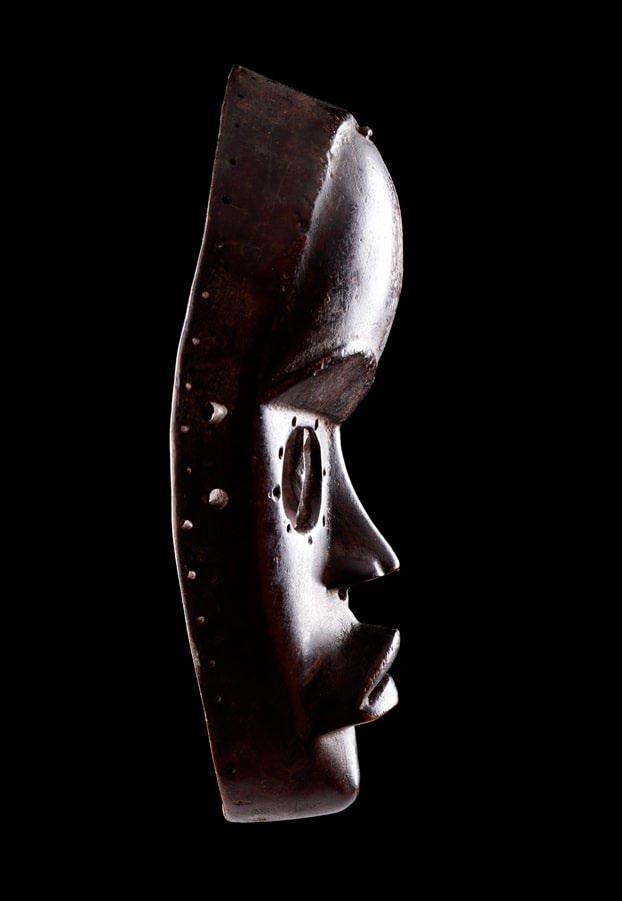
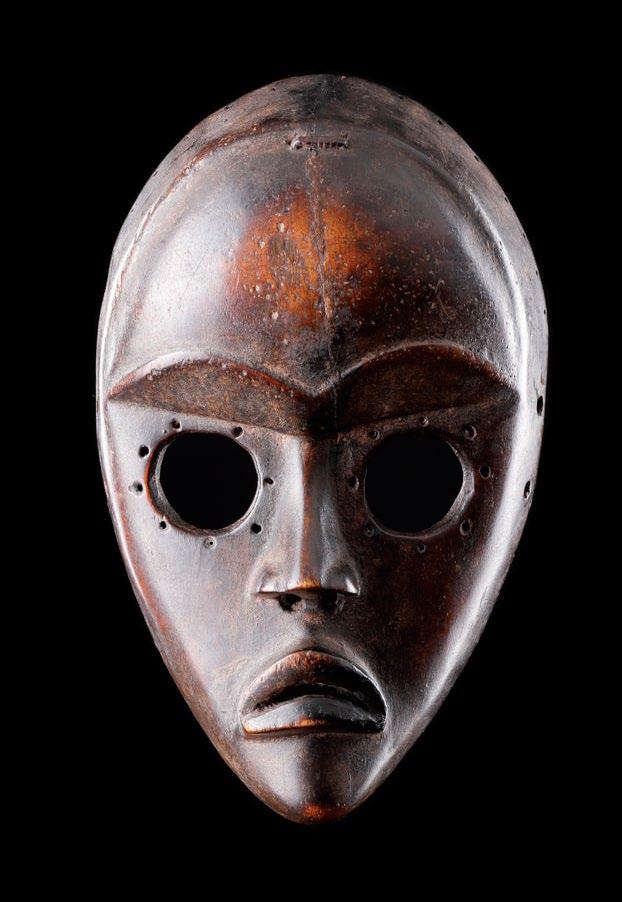
a ng O lian CH ai R
Chair Angola 19th century, circa 1850
89 cm x 44 cm
Provenance: Alain Guisson Price on request
Ob J e CT P R esen T e D b Y: Adam Prout
T.: + 44 7725 689 801 E.: adam@adamprout.com W.: www.adamprout.com
A superb interpretation of a Regency sabre leg chair African artists have historically responded to fresh design ideas. More often incorporating traditional cultural elements, this chair is unusual in being a near, true copy. A small sign of the African carvers’ compulsion for inventiveness can be seen in the top rail where they have incorporated an asymmetrical zigzag, something a European craftsman would never have done.


as H an T i DO ll
Akuaba fertility doll
Ashanti
Ghana
Early 20th century
Carved wood and beads
Height: 27 cm
Provenance: Philippe Ratton, Paris
Private collection, Paris
Olivier Klejman, Paris
Beppe Berna, Bologna
Private collection, Bergamo
Cécile Kerner, Brussels
Guilhem Montagut, Barcelona
exclusive price: 2.500 euros
Ob J e CT P R esen T e D b Y:
Julien Flak
M.: +33 6 84 52 81 36
E.: contact@galerieflak.com
W.: www.galerieflak.com
This type of Ashanti figure is called « Akuaba ». It represents youth and fertility. These carved figures were said to facilitate the conception of a child and ensure safe delivery at birth. Ashanti (Akan) women carried the dolls with them at all times. They treated them as if they were living babies, cuddling them, dressing them up, etc.
In terms of symbolism, the flat, disk-like head represents an ideal of beauty. The ringed neck is a symbol of beauty and prosperity. The small scars seen on the face of the akua’ba were made for medicinal purposes as protection against convulsions.
This superb Ashanti fertility doll will be featured in our summer pop-up exhibition in Aix-en-Provence (July 3-August 22). To schedule a private viewing in Provence, please contact Julien Flak: julien@galerieflak.com



aTaORO figu R e
Ancestor figure
Small island of Ataoro, Indonesia
Early 20th century
Height: 23 cm
Provenance:
Albert Bitran, who bought the piece in 1989 in gallery Antipodes, 3 Rue Des Beau Arts, Paris
Price on request
Ob J e CT P R esen T e D b Y: Louis Nierijnck Primal Art
T.: +31 6 558 974 85 E.:louisnierijnck@gmail.com W.: www.primitiveart.nl

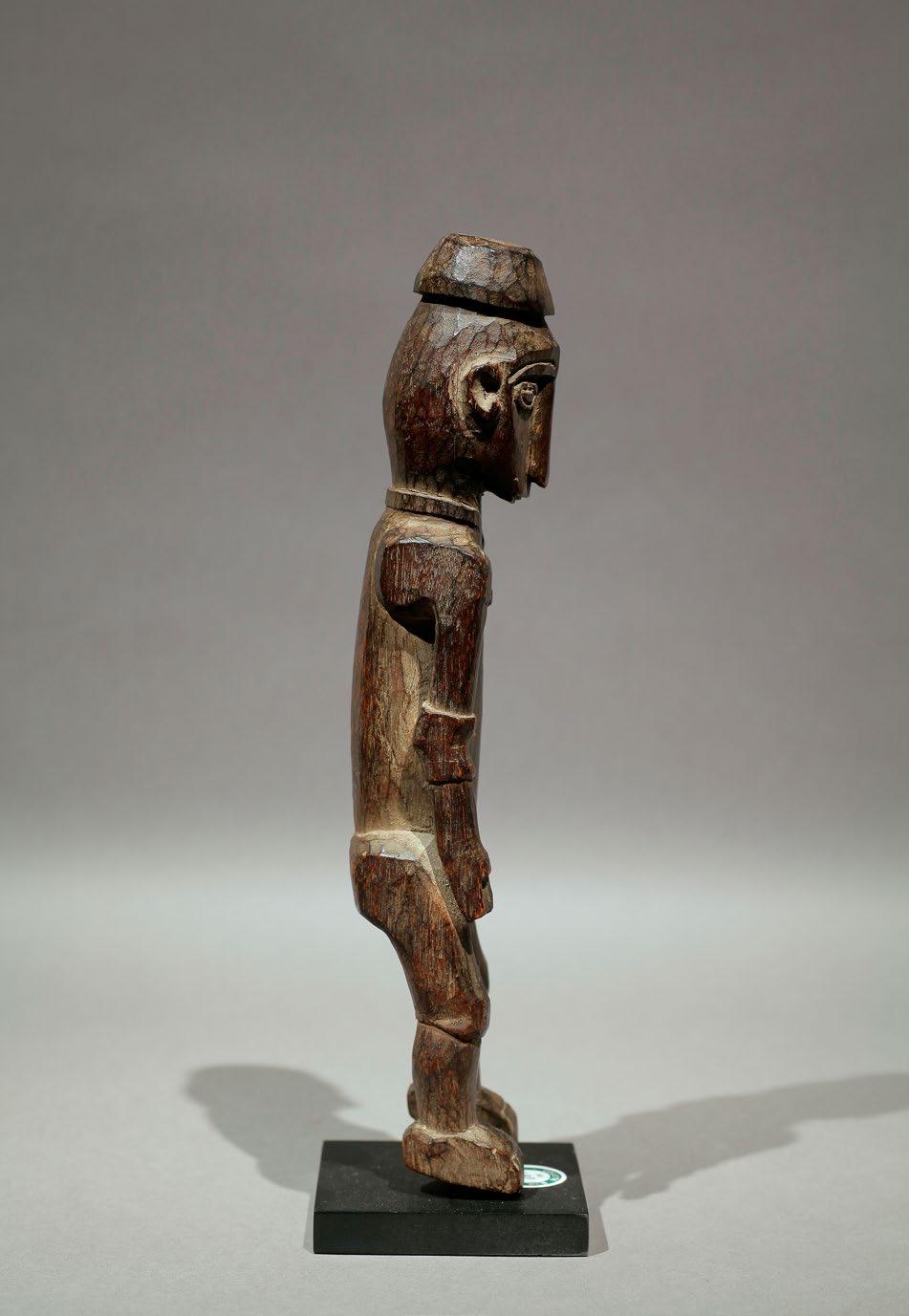
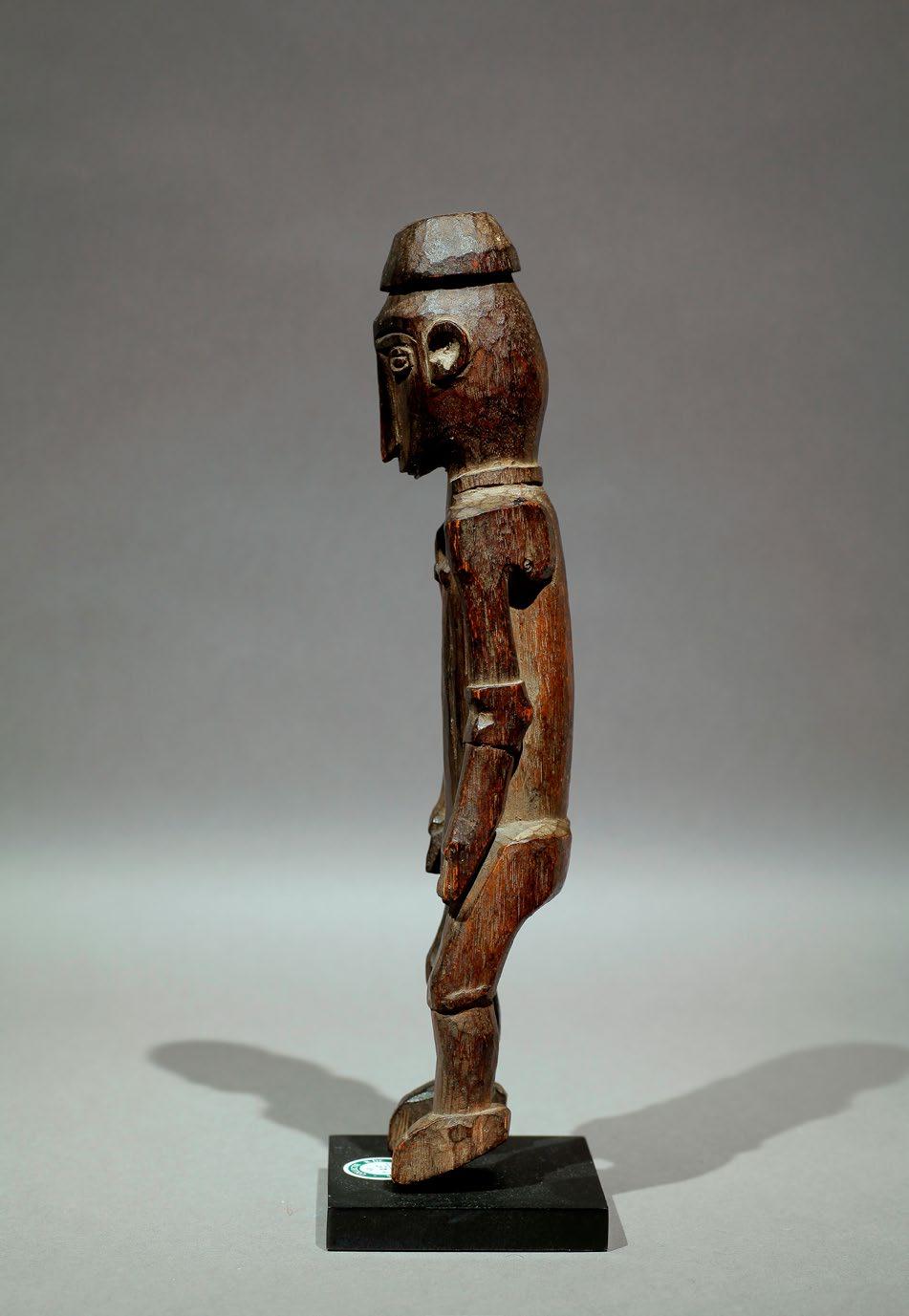
b a M ana M as K
Sule or n’gon mask
Bamana Mali
Early 20th century
Wood and metal
Height: 23 cm
Provenance:
Hélène & Philippe Leloup, France
Private collection, France
Price: 6.500 euros
Ob J e CT P R esen T e D b Y:
David Serra
T.: +34 (0) 667525597
E.: galeria@davidserra.es
W.: www.davidserra.es

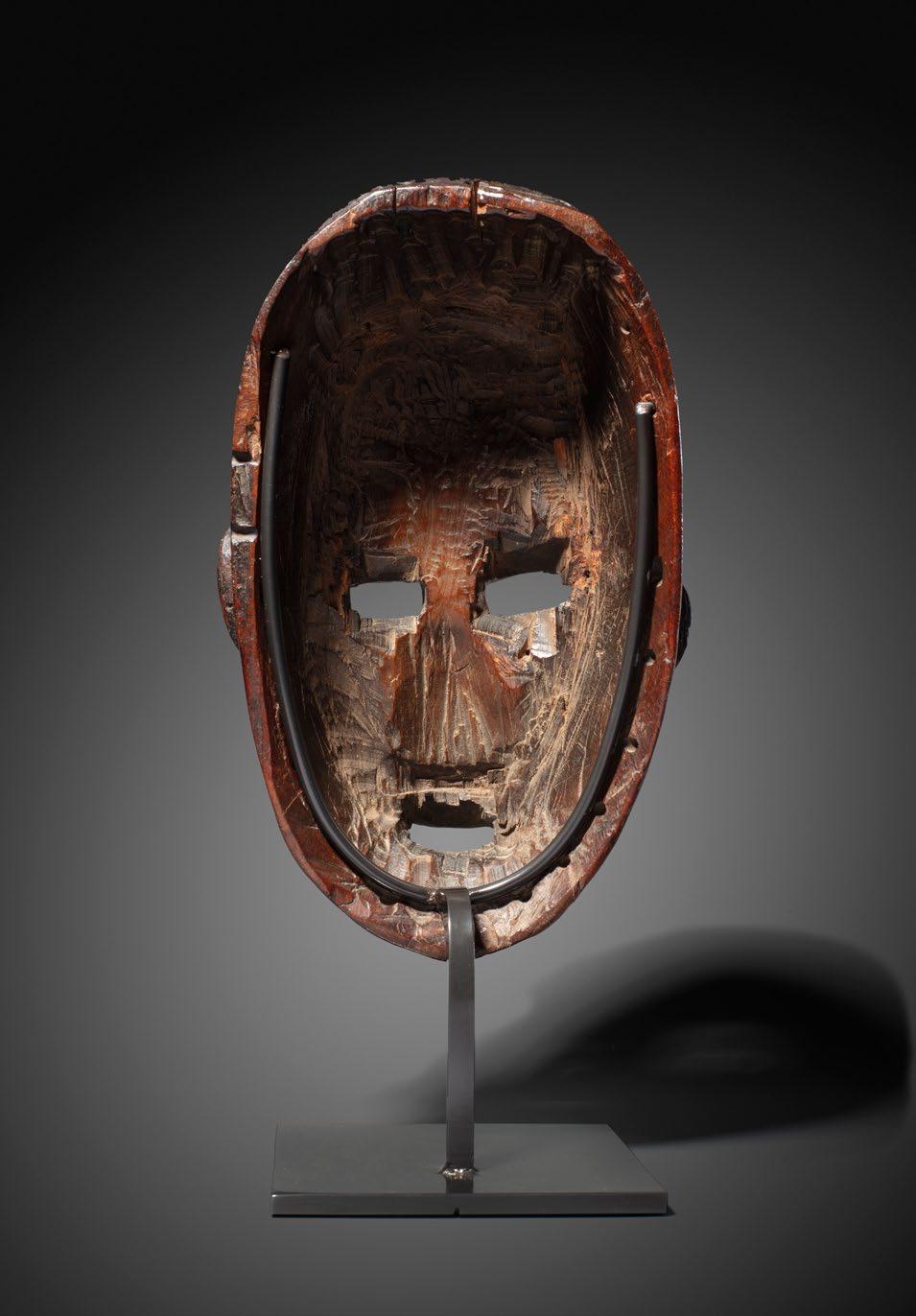

b aTa K b ulle T H O l D e R
Paru Paru with Chain Batak, North Sumatra, Indonesia 18th to early 19th century Horn, metal Height: 20 cm
Provenance: Private collection, San Francisco Price on Request
Ob J e CT P R esen T e D b Y: Thomas Murray M.: + 1 415.378.0716 E.: thomas@tmurrayarts.com W.: www.tmurrayarts.com
The Batak of Sumatra, famous as headhunters, were on the same trade routes that brought early flint locks to Japan from Europe in the 17th Century.The musket’s bullets were locally cast from lead and were kept in magical bullet holders that displayed an image of the primordial clan progenitor. We encounter a threatening smile, related to the famous giant Batak masks.



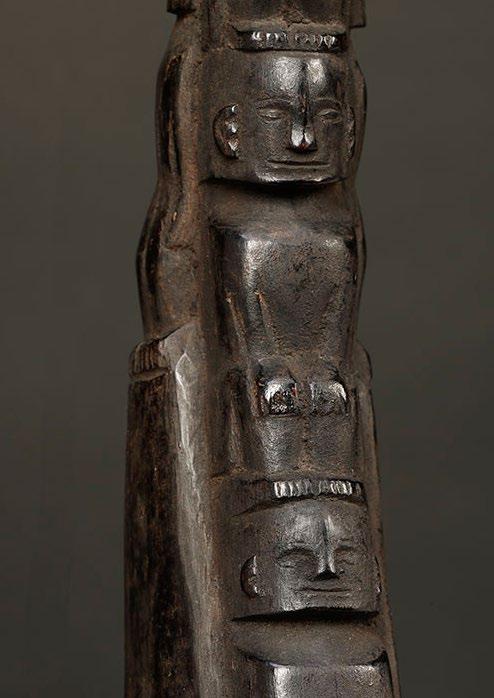
b aTa K HOR n
Batak Naga Morsarang Shaman’s
Horn
Batak
Sumatra, Indonesia
19th to early 20th century
25 cm x 56 cm x 6 cm
Price on request
Ob J e CT P R esen T e D b Y:
Thomas Murray
M.: + 1 415.378.0716
E.: thomas@tmurrayarts.com
W.: www.tmurrayarts.com
A Batak shaman, Datu, would always have at least three crucial objects in order to carry out his magical enterprises: a staff, tunggal panaluhan; a horn; Naga Morsarang; and a book of spells, pustaha. Of these, a great shaman’s horn would prove the most imposing sculpturally. The example presented here is a case in point. Observed is the mythological animal, singha expressed in an archaic dragon form, naga. Note the ancestor riders on the singha’s tail. This naga (serpent) element served as the stopper-cover for a horn that was filled with puk puk, an organic substance that served as a magical medicine.

b aule figu R e
Baule Ivory Coast Wood Height: 23 cm
Provenance: Private collection, Hampstead Price on request
Ob J e CT P R esen T e D b Y: David Malik
T.: +44 (0)7864133452
E.: david@davidmalikarts.com W.: www.davidmalikarts.com
Figure
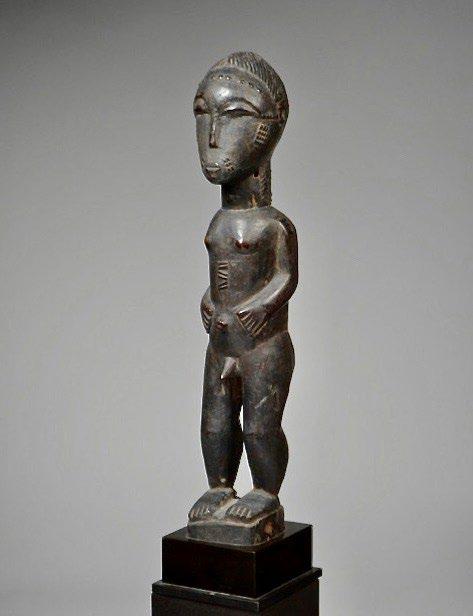

b aule figu R e
Monkey Figure
Baule
Ivory coast
20th century
Height: 58,7 cm
Provenance: David Serra
Price: 3.800 euros
Ob J e CT P R esen T e D b Y:
Guilhem Montagut
T.: + 34 931 414 319
E.: info@galeriamontagut.com
W.: www.galeriamontagut.com
Statues of standing monkeys were used in many different Baule cults, the most prominent of which was Mbra. According to Vogel (1997: 224) a ""man, woman, or child may be possessed by either of two kinds of powers: bush spirits, called asye usu, of which great numbers wander about in nature [...]; and Mbra, an ancient amuin (in other words a god), given to the Baule by the Creator, which can remain attached to certain families over generations. Both supernatural powers send their human partners into trance states [...] and there are similar beliefs about both. At least one substantial figure sculpture (usually more) should be created as an abode for the spirit or god, and this and the figure's numerous accessories make asye usu and Mbra cults the focus of much Baule art. [...] Only certain families have Mbra, having acquired it in past generations, and it lacks the close connection with the bush that asye usu have. Fewer persons are contacted by Mbra than by the multitude of bush spirits [...].""
Artists commissioned with the creation of sculptures used in the Mbra cult had to follow closely the instructions of the diviners who might have been told certain details about the figure's required physical appearance, posture, etc. by Mbra itself, often during a trance state or a dream. Vogel (1997: 238) notes: ""Monkey figures share stylistic features with the men's sacred masks, and have some of the same qualities of secrecy and danger to women. They combine human and animal traits in such a way that it is nearly impossible to separate them, and they have the prominent teeth and boxy muzzle[... They] also receive sacrificial offerings directly on the wood sculpture, and are associated with the bush. Mbra monkey figures, for example are kept in the village, but 'fed' with sacrifices in the bush.


10
Dan M as K
Mask
Dan Ivory Coast
Early 20th century
Wood, leather and fibers
Height: 22 cm
Provenance:
Private collection, United Kingdom (acquired by descendance)
Price: 5.000 euros
Ob J e CT P R esen T e D b Y:
David Serra
T.: +34 (0) 667525597
E.: galeria@davidserra.es
W.: www.davidserra.es

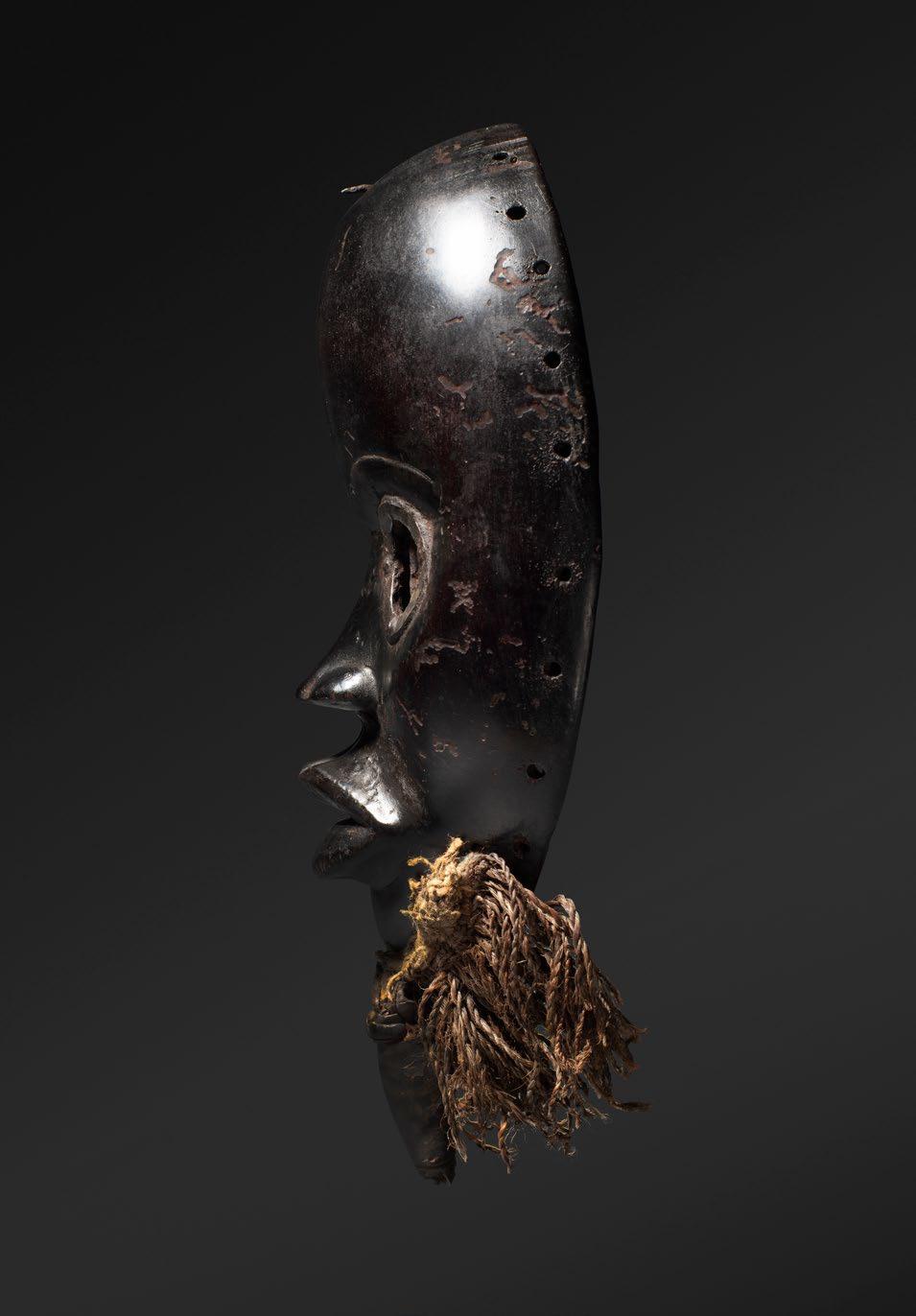
Dan-K O n OR OR g ue R zé M as K
Mask
Dan-Konor or Guerzé
Guinea / Liberia
Wood, animal fur, metal
Height: 23,5 cm
Provenance: Alexander S. Honig, New York, USA, till 1993
The Newark Museum, Newark, New Jersey, USA (X94.7)
Private collection, USA
Sotheby's, New York, ""The Alexander S. Honig Collection of African Art"", 18 May 1993. Lot 66 Price on request
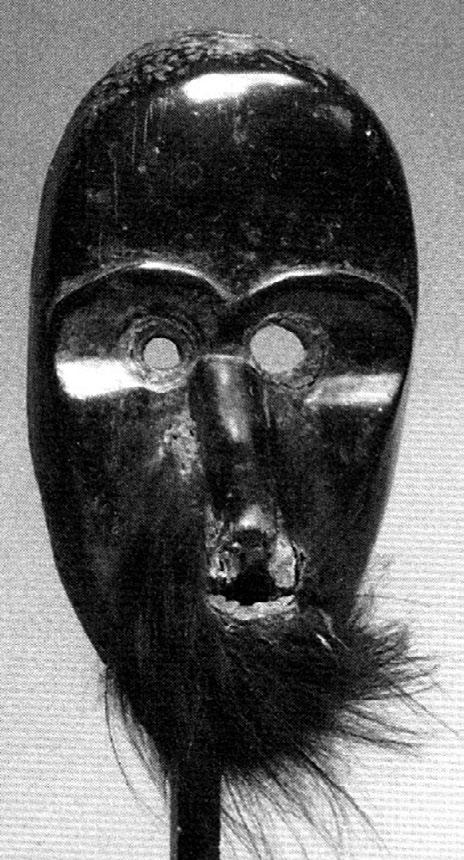
Ob J e CT P R esen T e D b Y:
David Malik
T.:+44 (0)7864133452
E.: david@davidmalikarts.com
W.: www.davidmalikarts.com

D O g O n figu R e
Double Figure
Dogon Mali
18 century or before Height: 50 cm
Provenance:
John and Nicole Dintenfass, NY
James Stephenson, NY
Gilbert Graham, Long Island
Price on request
Ob J e CT P R esen T e D b Y:
Guilhem Montagut
T.: + 34 931 414 319 E.: info@galeriamontagut.com W.: www.galeriamontagut.com
Replete with ritualistic symbols and mythological references, Dogon statuary is inextricably linked to the cosmogony of its creators and cannot be understood separate from its social, historical, and cultural context. On this type of sculpture in particular, scholars have proposed persuasive interpretations of its iconography, though, in the absence of written history, precise meanings remain conjectural.

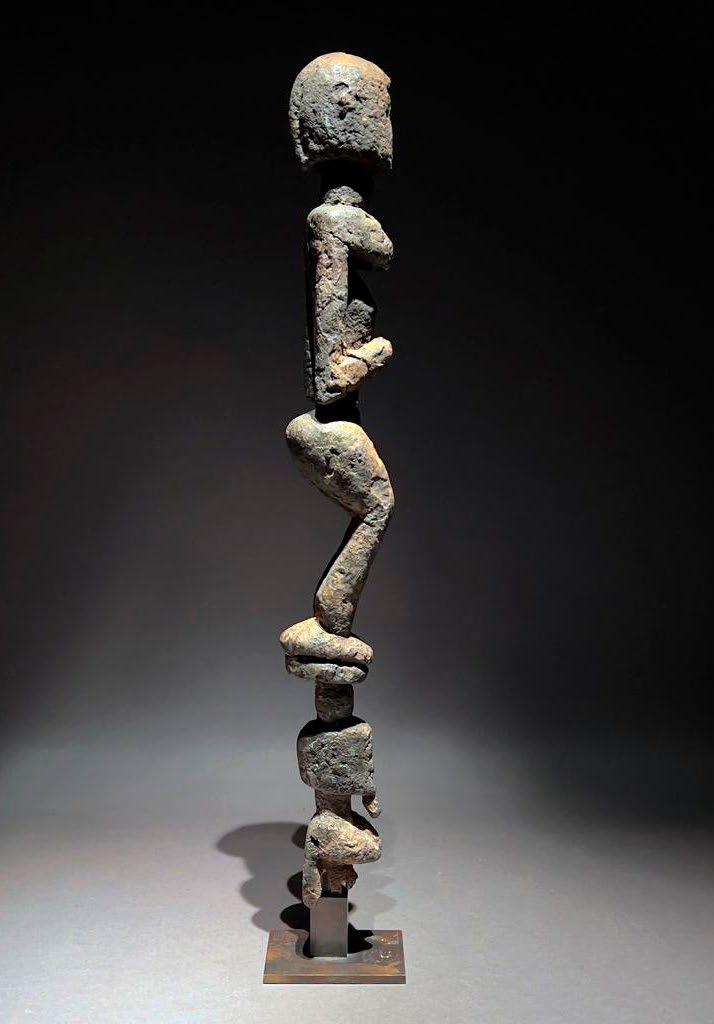

DOgOn sTaff
Staff yo domolo
Dogon
Mali
15th century to 17th century (C-14 analysis by CIRAM: 0124-OA064J-1)
Wood
25,5 cm (h.) x 39,5 cm (l.)
Provenance:
Jean Herment (1927-1974), France (Acquired in Mali in the 1960s)
Gilbert Huguenin, Switzerland 1970’s Private collection, Switzerland
Publications:
Expo cat.: Gilbert Huguenin. DegueDegue. Les Tellems et les Dogons, Auvernier, Switzerland: Galerie Numaga, 1973. P. 11. Price on request
Ob J e CT P R esen T e D b Y:
David Serra
T.: +34 (0) 667525597
E.: galeria@davidserra.es
W.: www.davidserra.es

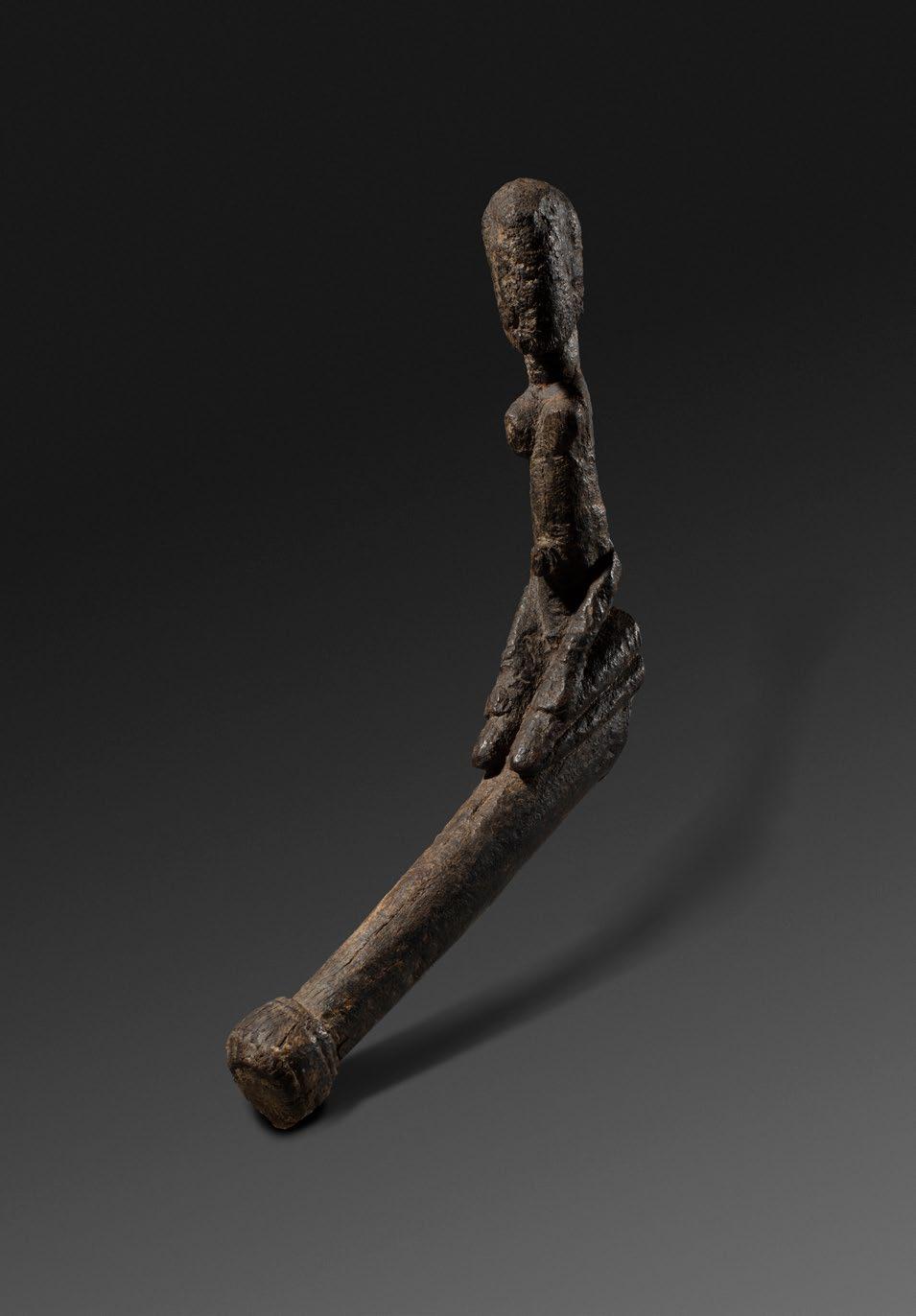

iaTM ul flu T e
s TOPP e R
Flute stopper
Iatmul
Middle Sepik, P.N.G.
Early 20th century
Carved wood and pigments
Height: 38,5 cm
Provenance: Bruce Frank, New York
Pierre Mondoloni, France, acquired from the above in January 2009 exclusive price: 7.000 euros
Among the Iatmul communities of the Sepik River in Papua New Guinea, sacred flutes hold a vital role in initiation rites and ceremonial life. The wooden flute stoppers, often intricately carved and adorned, are far more than functional accessories— they embody ancestral spirits or totemic beings and enhance the instrument’s spiritual resonance. Stored within men's ceremonial houses, these stoppers serve to symbolically “seal” the ancestral breath when the flutes are not in use. Their sophisticated craftsmanship reflects the profound interconnection between music, ritual, and artistic expression in Iatmul culture.
This anthropomorphic Sepik flute stopper will be featured in our summer pop-up exhibition in Aix-en-Provence (July 3-August 22). To schedule a private viewing in Provence, please contact Julien Flak: julien@galerieflak.com
Ob J e CT P R esen T e D b Y:
Julien Flak
M.: +33 6 84 52 81 36
E.: contact@galerieflak.com
W.: www.galerieflak.com

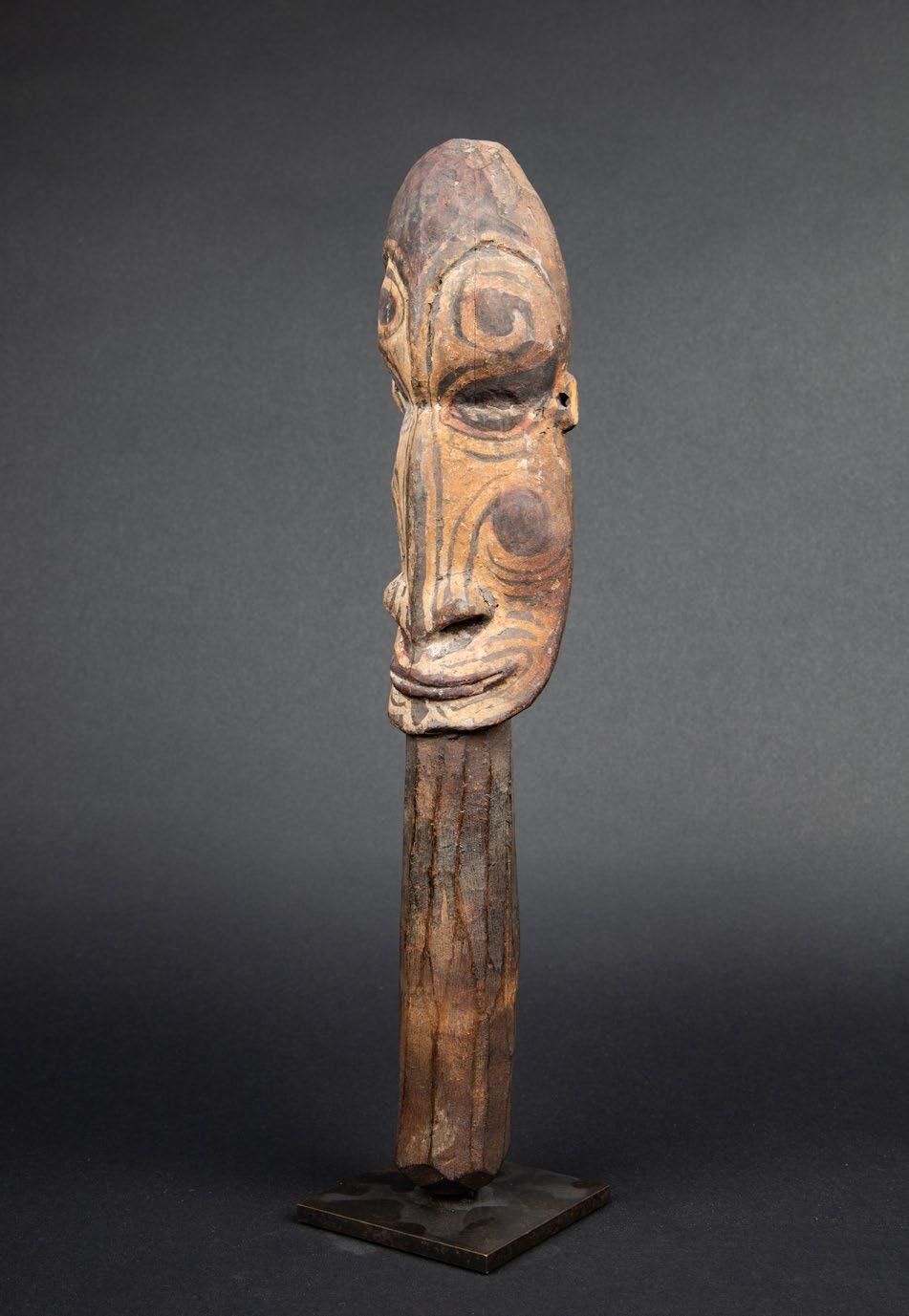
Kuba figu R e
Janus figure
Kuba
D.R. of the Congo
Western Kassai, Central Congo
Wood
Height: 20 cm
Provenance:
Field collected in situ circa 1925
Charles Ratton (1895-1986), Paris
Private collection
Galerie Ratton-Hourdé, Paris (2013)
Private collection, New York
Marc Assayag, Montreal(2016)
Private collecton, Los Angeles
Mark Eglinton, inv.3611 (2024)
Published in:
Galerie Ratton, 2013, Published: Série Noire (Ratton)
Exhibited:
Paris, France: ""Série Noire"", Galerie Philippe Ratton, June 2013
AHRDC:
Van Rijn Archive- 0136895 Price on request
Ob J e CT P R esen T e D b Y:
Mark Eglinton
M.: +1 646-675-7150
E.: markeglinton@icloud.com
IG.: @markeglintontribalart

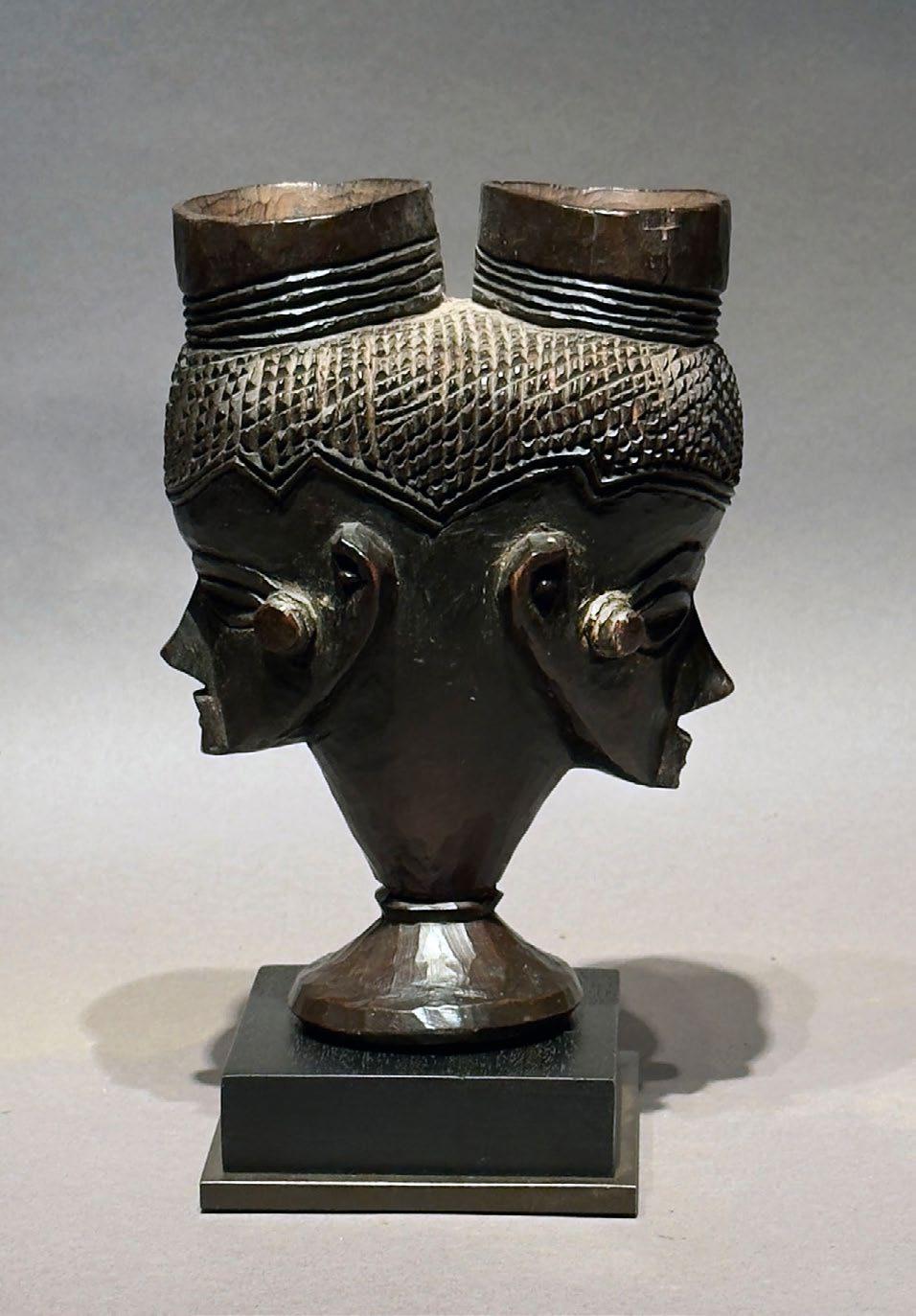

YORuba OR n u P e RO be
Robe
Yoruba or Nupe Nigeria 19th century
Embroidered in 6 colours with the 8 knives pattern
On a loosely strip woven ground of Alaari silk and cotton.
Colours: pale blue, dark blue, pale mustard, deep green, alaari pink and taupe
sleeve openings edged in blue
127 cm (h.) x 118,5 cm (w.), each strip 6,5 cm (wide)
Provenance: The English art market Price on request
Ob J e CT P R esen T e D b Y: Diane Hall Artifacts
E.: diane@dianehallartifacts.com
T.: +32 (0)473 135 815
A rare and enigmatic robe, one of two known examples with multicoloured embroidery, most likeley embroidered by an itinerant Muslim scholar and not in a workshop. As such scholars travelled around Nigeria fufilling local needs there is no way to pinpoint exactly where it was made.
Although the quality of the embroidery lacks the precision of a professional embroiderer, it has the charm and quirkiness of folk art.
The only related robe is in the Textile Museum of Canada in Toronto, published in Clarke, Duncan, et al. African Textiles, 2022, p.298
https://collections.textilemuseum.ca/ collection/1110/
Condition: Some minor staining and colour run



lulu W a figu R e
Female figure
Luluwa/Bena Lalua
D.R. of the Congo
19th/20th centuty
Wood and pigments
Height: 17 cm
Provenance: Galerie Ambre Congo / Pierre Loos & Thomas Bayet, Brussels
Collection Christian Zingg (1956-2023), La Chaux-de-Fonds. Switzerland. Private collection (aquired from the above in (2021)
AHRDC: Van Rijn Archive- 0207650 Price on request
Ob J e CT P R esen T e D b Y:
Mark Eglinton
M.: +1 646-675-7150
E.: markeglinton@icloud.com
IG.: @markeglintontribalart
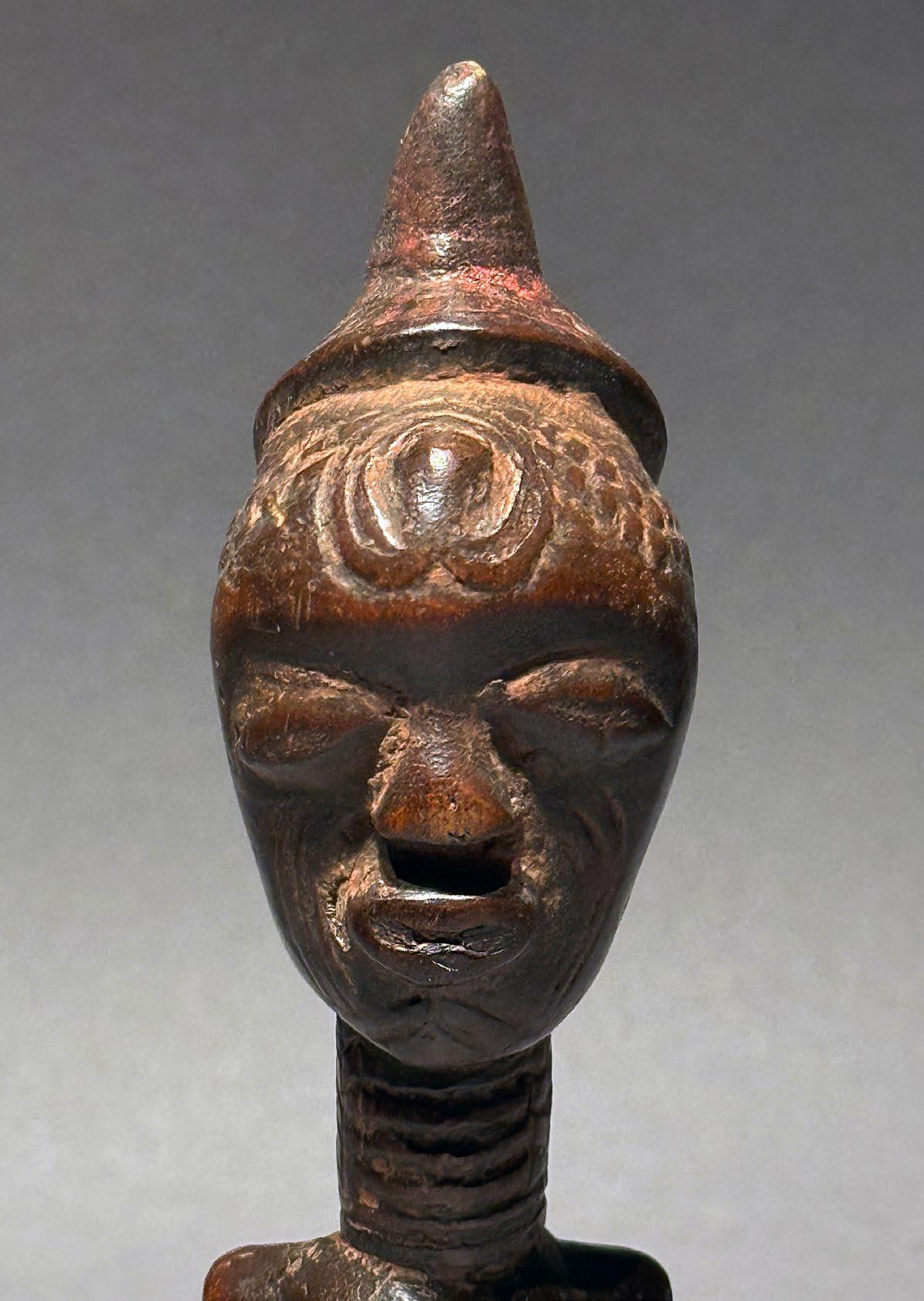


MaOR i C lub
Taiaha Staff Club
Maori
New Zealand
19th century
Height: 146 cm
Provenance:
Long Island, N.Y. collection
Nancy and John Hyde Devoe, NYC. and N.J., active 1950's - 1970's
Price: 4.300 euros
Ob J e CT P R esen T e D b Y:
Guilhem Montagut
T.: + 34 931 414 319
E.: info@galeriamontagut.com
W.: www.galeriamontagut.com
Long weapon of authority, the short point of classic form with finely carved Janus faces, one set of eyes still retaining mother-of-pearl ""haliotis"" shell disc irises with traces of red sealing wax, raised mouth ridge, and thrusting tongue out in the form of the pointed blade. The long shaft and blade engraved with curvilinear and foliate patterns of less precise style possibly added later. Red-brown smooth patina. The taiaha, a traditional Maori quarterstaff, was a symbol of status carried by high-ranking Maori men.
Beyond its ceremonial significance, the taiaha served practical purposes in oratory, hand-to-hand combat, and ceremonial displays. Unlike a spear, it was specifically designed for parrying and sparring, with its flat, spatulate end used to inflict harm. The pointed end, adorned with a Janus-like face and a protruding tongue, was employed for prodding during sparring. This design reflects the Maori custom of aggressive facial expression with extending tongue, a ritualized gesture among warriors. The art of wielding the taiaha was a disciplined practice, meticulously taught and observed, resembling the precision and technique of European fencing or swordsmanship in the 19th century.
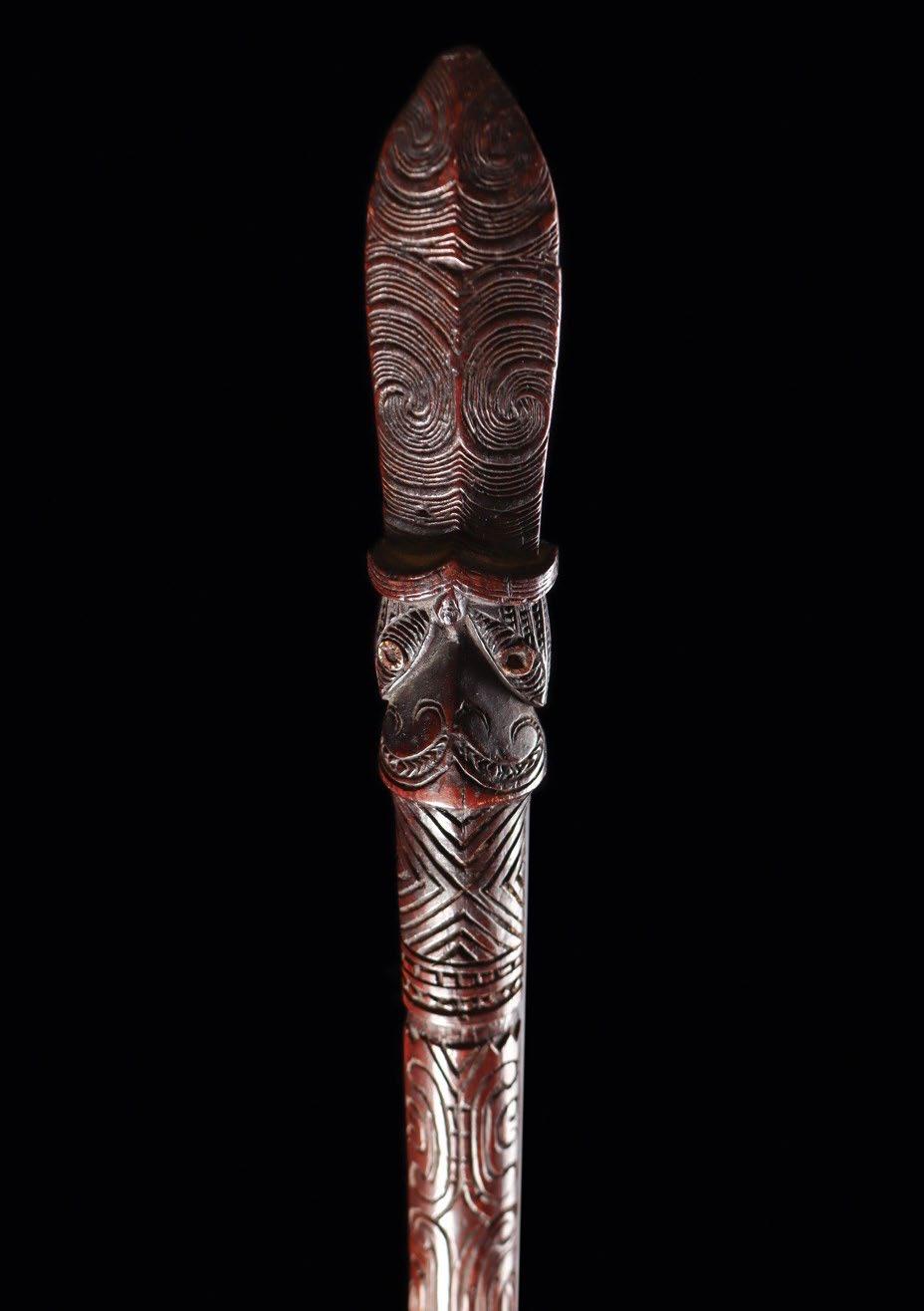
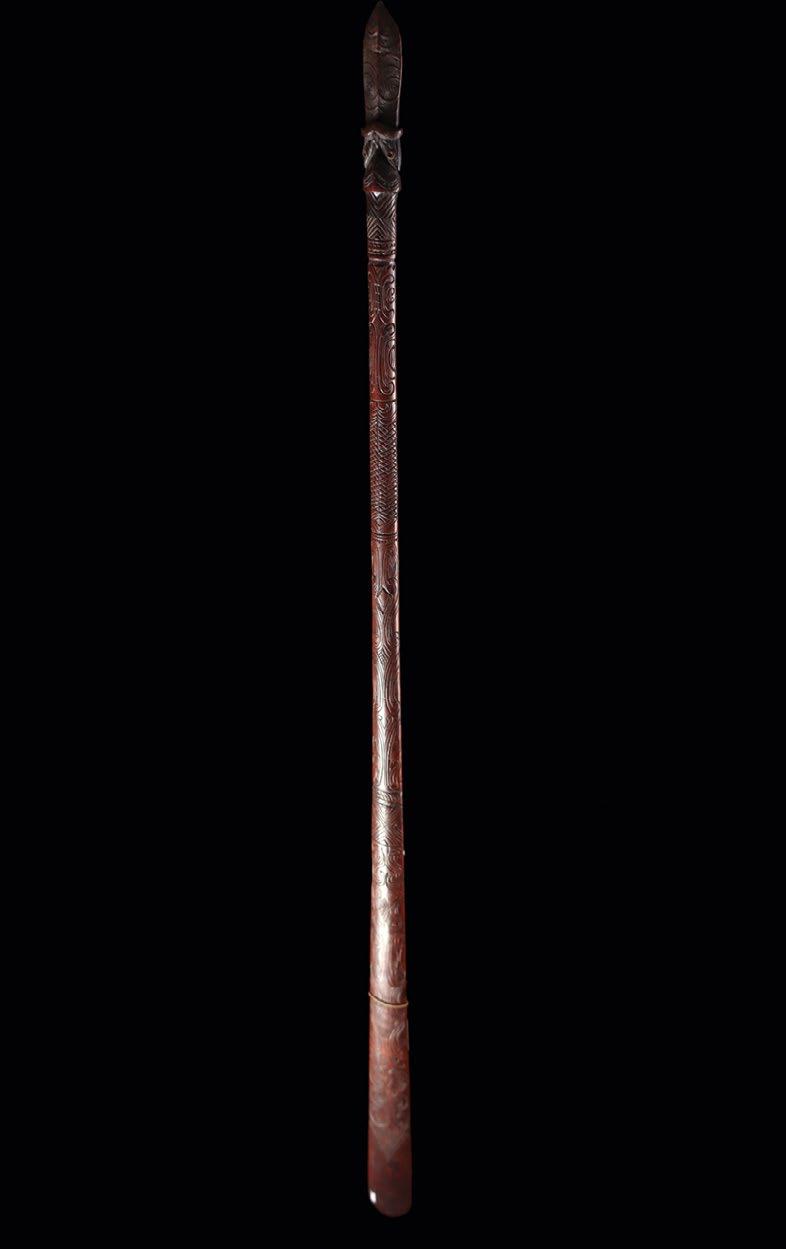
n ias figu R e
Adu Nuwu ancestor figure Nias island, indonesia 19th to very early 20th century Wood
25 cm x 5 cm
Provenance: Private collection, San Francisco Price on request
Ob J e CT P R esen T e D b Y: Thomas Murray M.: + 1 415.378.0716 E.: thomas@tmurrayarts.com W.: www.tmurrayarts.com
This sculpture features a prominent single earring, indicating a male member of a royal family. The difference in color of the wood informs us that this figure was clothed for a long time of its existence.



Punu M as K
Ikwara' mask
Punu
Gabon
Wood
Height: 27 cm
Provenance:
Galerie Le Corneur Roudillon, Paris
1954
Galerie Joris Visser, Brussels
Bernd & Rita Schlimper, Düsseldorf
Private collection, Rheinland-Pfalz, Germany
Price on request
Ob J e CT P R esen T e D b Y:
David Malik
T.: +44 (0)7864133452
E.: david@davidmalikarts.com
W.: www.davidmalikarts.com

sO l OMO n T evau
Red feather money coil or ‘Tevau'
Santa Cruz, Nendö, Solomon Islands 19th century
Retaining an original wrapping leaf
Length: 830 cm (fully unrolled)
Provenance:
Sammlung Rinck-Hollnberger, Munich (collected in the 1970s)
Price on request
Ob J e CT P R esen T e D b Y: Zebregs&Röell +31 6 207 43671 dickie@zebregsroell.com W.: www.zebregsroell.com
One of the most remarkable forms of currency found throughout Oceania are tevau, feather money coils from the Santa Cruz Islands in Temotu Province at the eastern end of the Solomon Islands chain. The manufacture of tevau was localised to the island of Ndende (Nendö), but as valuables they were traded through the Reef and Duff Islands to the north.
The coils are made from the feathers of the scarlet honeyeater (Myzomela cardinalis), known locally as mungau. Throughout much of the Pacific, red feathers are revered as a sacred and spiritually charged material, and as such, they are a valuable exchange item. The production of tevau is the work of three distinct specialists. One man was responsible for trapping the birds and harvesting their feathers. Another would fix the red feathers into small plates by using tree gum to adhere them to a structure of larger pigeon feathers. A third specialist would assemble the plates onto a woven base supported by a bark coil. The specialist knowledge involved in making tevau was held in certain family lines and tightly guarded. According to legend, the knowledge was first taught to humans by forest dwelling spirits, who warned that if the men shared what they had learnt they would lose their good fortune.
The value of tevau is determined by the size and quality of the red feathers. A tevau of this size would likely contain the feathers of 300 or more birds and have taken hundreds of hours to make. The value of the coils would decline as the feathers weathered and faded, so the most valued were those that were vital, red and fresh. A turtle shell charm placed inside this coil further adds to its value. The stings of coix seeds and small shells that are attached to the piece are a marker of time and labour involved in its manufacture and are placed at the start, end, and centre points of the coil. For both spiritual and environmental protection, tevau would be stored wrapped in leaves and suspended from the rafters of houses, where the smoke from fires would ward away insects while wooden charms placed in the wrappings protected against malevolent spirits.

Tevau could be used in payment for high-value items such as canoes and the pigs that are central to the village economies in many Pacific cultures. Tevau also played an important role in the payment of bride wealththe compensation to the bride’s family for the loss of her generative potential as a mother and grower of crops. Other uses for tevau included compensation payments to settle disputes, presentations to ancestral spirits, and as payments for courtesans from the Reef Islands who were purchased to reside in the men’s house.
During the twentieth century, knowledge of how to make tevau largely diminished in the islands as cash replaced feather money within the local economy. However, in recent years there have been attempts in Temotu Province to revive tevau, and in the year 2000 three men from Noipe village in Santa Cruz were trained in the sacred knowledge of tevau making.
For a comparable piece in the collection of the Metropolitan Museum of Fine Art, see: access.no. 2010.326.


Ti MOR s POO n
Ceremonial spoon with anthropomorphic figure
Timor
Early 20th century
Beautiful glossy patina
Length: 25 cm
Provenance: David Serra, Spain
Private collection, The Netherlands
Price on request
Ob J e CT P R esen T e D b Y: Louis Nierijnck Primal Art
T.: +31 6 558 974 85 E.: louisnierijnck@gmail.com W.: www.primitiveart.nl



These decorated cloths were reserved for royalty and people of importance.
u gan D a ba RKC l OTH
A large very thin and delicate barkcloth Olubugo Uganda
Early 20th century or earlier
Large decorated cloth: 3 m x 16 cm x 183 cm
Price on request
Ob J e CT P R esen T e D b Y: Adam Prout
T.: + 44 7725 689 801 E.: adam@adamprout.com W.: www.adamprout.com



vanuaT u b R a C ele T
Bracelet
Malekula Island, Vanuatu 19th or early 20th century
Worn on the upper arm, glass trade beads and fibre. Very good condition
7 cm (w.) x 10 cm (diam.)
Price on request
Ob J e CT P R esen T e D b Y: Adam Prout
T.: + 44 7725 689 801 E.: adam@adamprout.com W.: www.adamprout.com

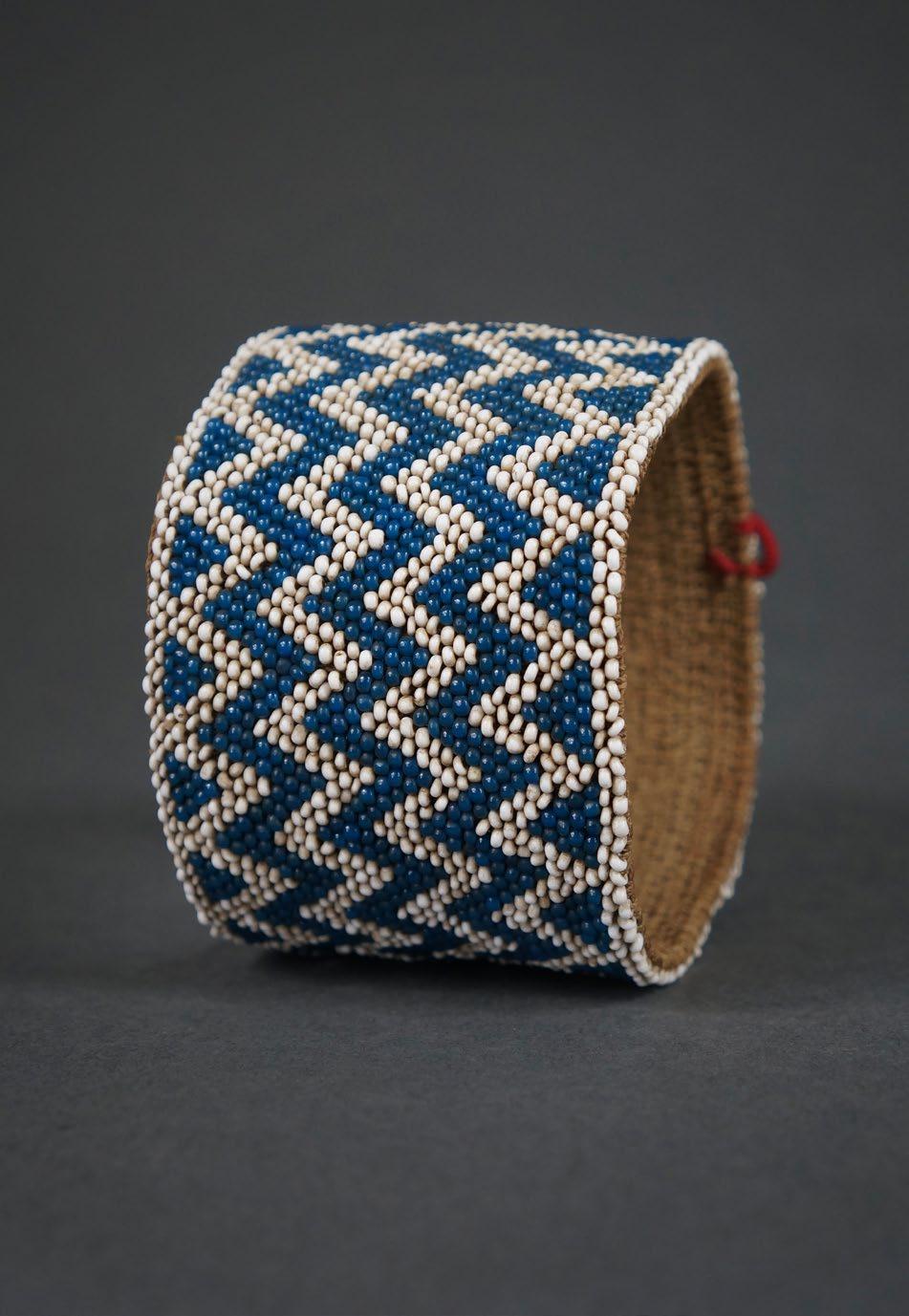
W un D a s H iel D
Wunda shield
Aboriginal Western Australia
19th century
Carved wood and pigments
Height: 74 cm
Provenance: Andrey Tischenko, Finland
Exclusive summer price: 3.800 euros
Such shields from Australia are known as wunda, a name derived from the Paljgu word wunrnda, referring to the type of wood originally used to carve them.
They served as parrying shields in warfare, used to deflect spears and boomerangs. Wunda shields were also actively traded across Western and Central Australia.
In addition, they played a role in initiation ceremonies and ritual contexts. The painted motifs on their surface are totemic symbols, often linked to ancestral songlines
In his 1987 book « The Songlines », British novelist and travel writer, Bruce Chatwin describes the songlines as:
« ...the labyrinth of invisible pathways which meander all over Australia and are known to Europeans as 'Dreaming-tracks' or 'Songlines'; to the Aboriginals as the 'Footprints of the Ancestors' or the 'Way of the Law’. Aboriginal Creation myths tell of the legendary totemic being who wandered over the continent in the Dreamtime, singing out the name of everything that crossed their pathbirds, animals, plants, rocks, waterholes - and so singing the world into existence. »
A selection of shields of Oceania will be featured in our summer pop-up exhibition in Aix-en-Provence (July 3-August 22). To schedule a private viewing in Provence, please contact Julien Flak: julien@ galerieflak.com
Ob J e CT P R esen T e D b Y:
Julien Flak
M.: +33 6 84 52 81 36
E.: contact@galerieflak.com
W.: www.galerieflak.com


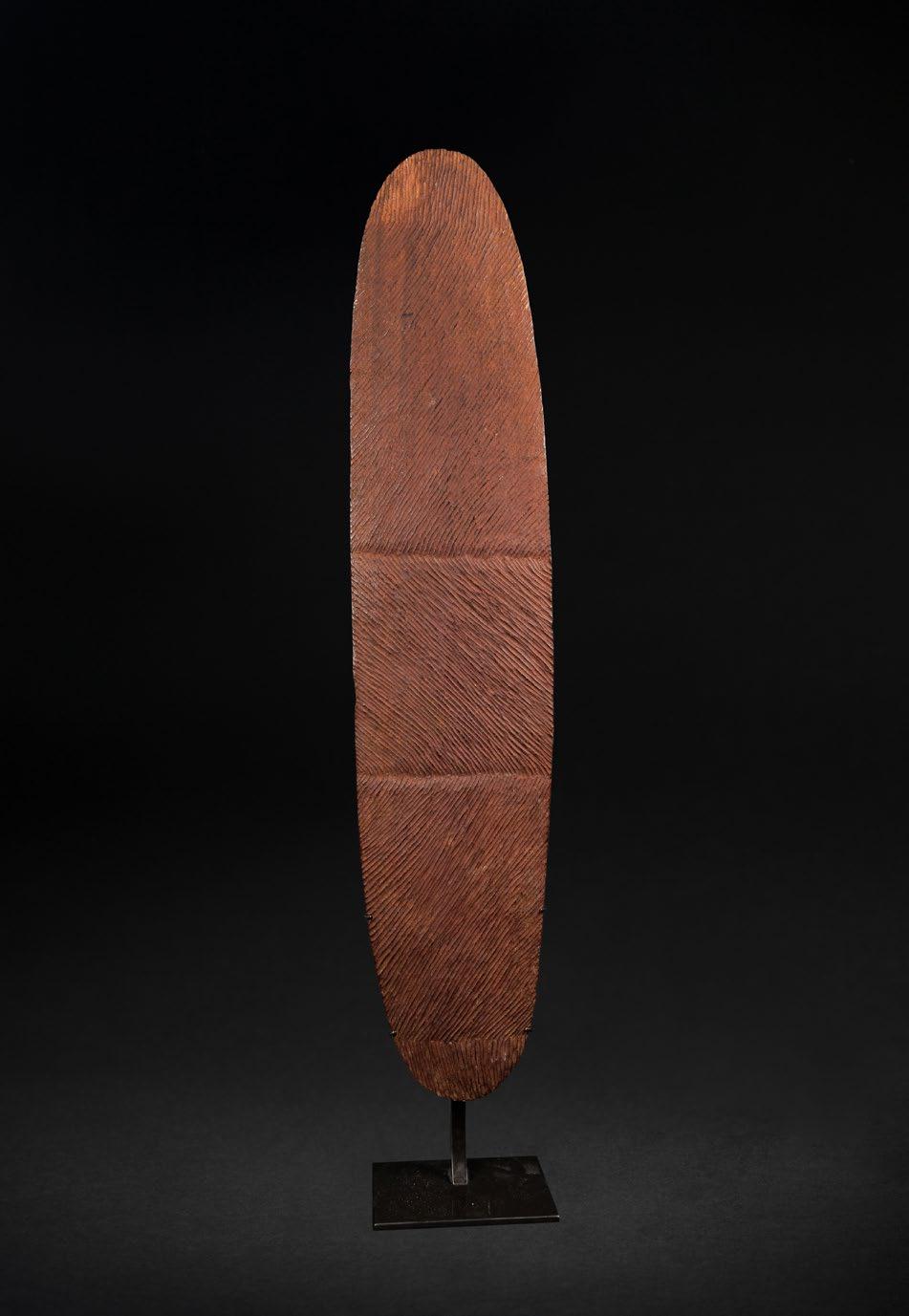
n ias s C ul PT u R e
Adu Zatua ancestor sculpture Nias
Indonesia
Early 20th century
Height: 32 cm
Provenance: Christophe Rolley Private collection Price on request
Ob J e CT P R esen T e D b Y: Louis Nierijnck Primal Art T.: +31 6 558 974 85 E.: louisnierijnck@gmail.com W.: www.primitiveart.nl
These figures were commissioned by high-ranking families in memory of a deceased relative.

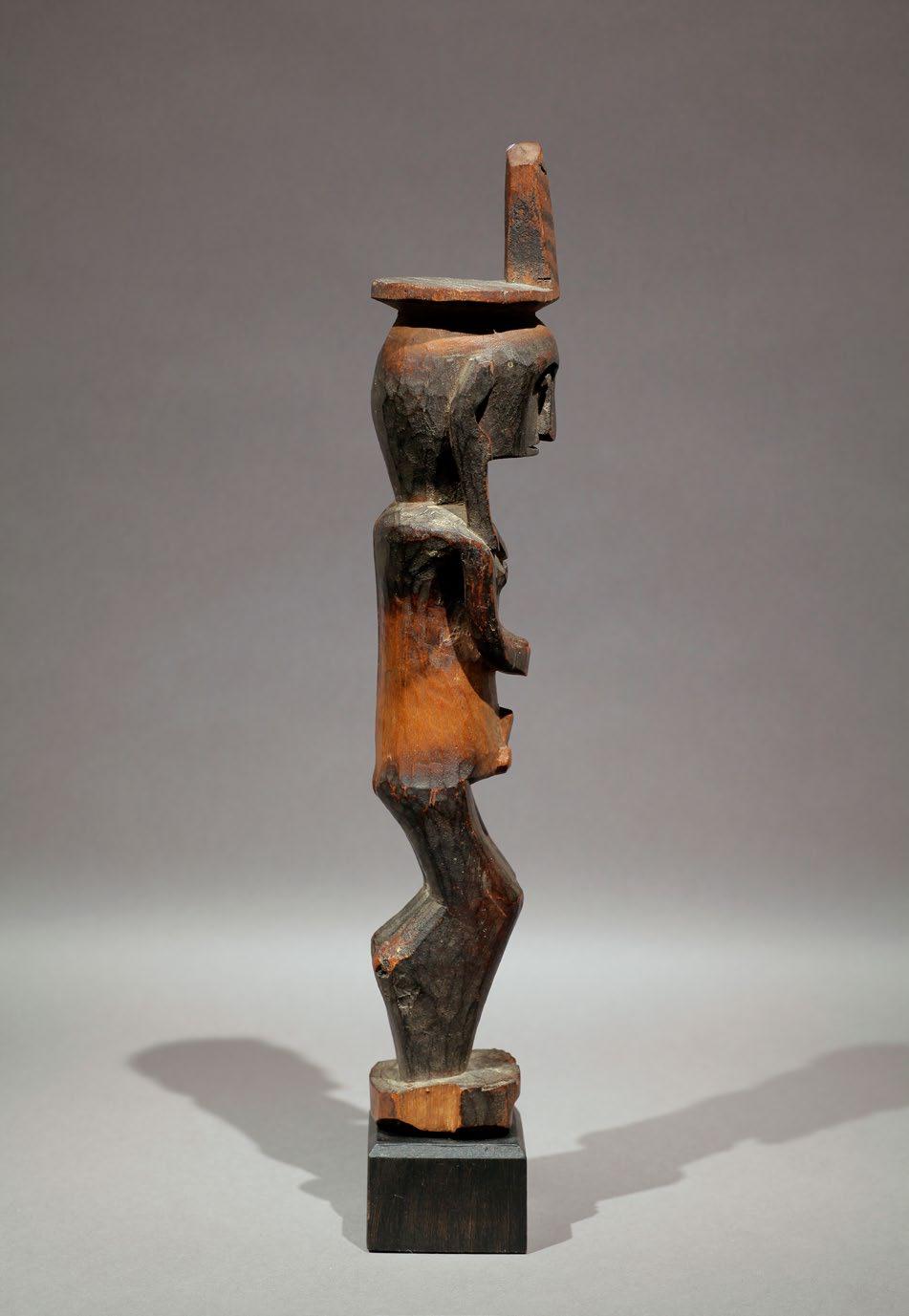

l ega Mas K
Mask
Lega
D.R. of Congo
First half of 20th century
Wood, pigment, fibre
Height: 10 cm
Provenance:
Acquired in situ in 1959 by Lore Kegel
Boris Kegel-Konietzko
Collection no.: 216-17
Market debut: 2025
Price on request
Ob J e CT P R esen T e D b Y: Alex Dorn
Kegel-Konietzko & Dorn
T.: +49 (0) 1718636931
E.: alex.dorn@kkd-gallery.com
W.: www.kkd-gallery.com



